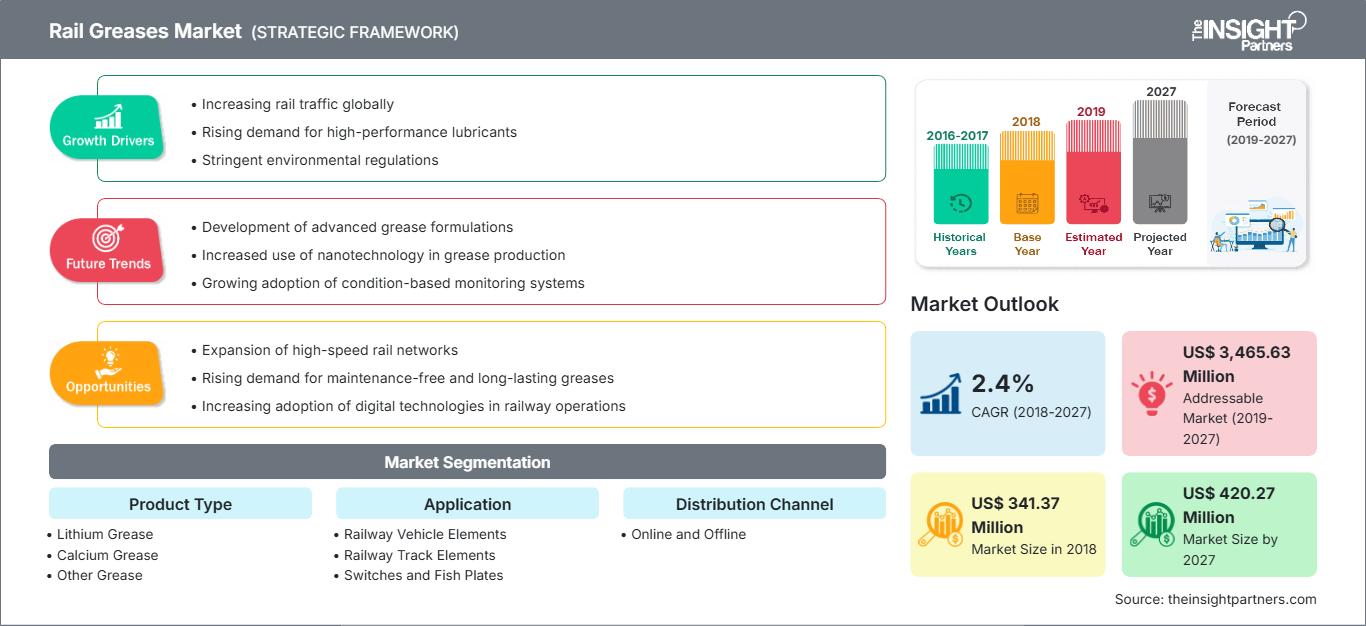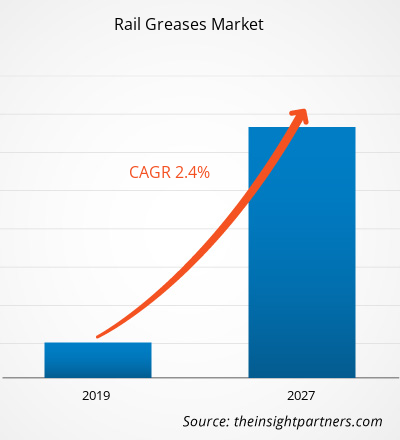2018 年,铁路润滑脂市场价值为 3.4137 亿美元,预计到 2027 年将达到 4.2027 亿美元;预计 2019 年至 2027 年的复合年增长率为 2.4%。
润滑脂是一种固体或半固体润滑油。它通常由矿物油和增稠剂(例如钙基皂和锂基皂)组成。润滑脂还可能包含其他润滑颗粒,例如二硫化钼、石墨或聚四氟乙烯 (PTFE)。不同类型的润滑脂结合了油的润滑性能和额外的粘性,使润滑剂能够更好地粘附在表面。润滑脂具有诸如高初始粘度等特性,这使其具有摩擦性。它广泛用于汽车、铁路、建筑、制药、食品饮料和采矿等各个行业。对于轨道而言,润滑脂可用于需要频繁润滑且润滑油停留时间不长的机构。润滑脂可作为密封剂,防止水和不可压缩材料的渗入。润滑脂还用于各种轨道部件的维护,例如车轴和车轮、轴承和链条、制动元件、内部组件、受电弓和轨道部件,因为它可以防止污染物进入或润滑剂流失。
2018年,亚太地区在全球轨道润滑脂市场中占据主导地位,市场份额最高,预计在预测期内将成为增长最快的地区。该地区轨道润滑脂市场的增长主要得益于新兴国家经济的蓬勃发展、快速的城市化以及政府对铁路基础设施建设的不断投资。该地区各国正在试验最先进的交通技术,以提高城市轨道交通系统的效率、可靠性和乘客舒适度。亚太地区的地铁系统正逐步从半自动运行转向无人驾驶/无人驾驶列车运营。大多数即将投入运营的系统都引入了尖端技术解决方案,以确保乘客的舒适性和安全性。因此,预计该地区的轨道润滑脂市场将快速增长。此外,预测期内,该地区政府在传统铁路网络数字化方面的众多举措也将推动轨道润滑脂市场的增长。
自定义此报告以满足您的要求
您将免费获得任何报告的定制,包括本报告的部分内容,或国家级分析、Excel 数据包,以及为初创企业和大学提供超值优惠和折扣
铁路润滑脂市场: 战略洞察

-
获取本报告的主要市场趋势。这个免费样本将包括数据分析,从市场趋势到估计和预测。
COVID-19疫情对铁路润滑脂市场的影响
COVID-19疫情于2019年12月起源于中国武汉,此后迅速蔓延至全球。截至2020年7月,美国、俄罗斯、印度、意大利、中国、西班牙、法国和德国是确诊病例和死亡人数最多的国家。由于强制封锁、旅行禁令和企业停工,疫情影响了各行各业。COVID-19疫情蔓延后,由于供应链中断、封锁导致的生产中断以及疫情导致的办公室关闭,各地区对铁路润滑脂的需求均受到抑制。亚太和北美等主要地区的多家工厂停工停产,影响了轨道交通润滑脂的生产、交付计划和销售,从而对全球轨道交通润滑脂市场产生了负面影响。
市场洞察:铁路运输中不同部件的定期维护活动
车轴和车轮、轴承和链条、制动元件、内部组件和受电弓等轨道车辆部件需要频繁维护和润滑,以确保平稳运行和高性能。在车轮上涂抹润滑脂具有多种优势,例如降低人工成本、延长维修间隔和减少润滑剂消耗。在轨道车辆部件上使用润滑脂具有多种运行优势,例如提高设备可靠性、减少计划外停机时间、降低能源和燃料消耗以及提高设备盈利能力。此外,润滑脂还有助于节能降噪。车辆轨道系统的轴箱轴承是铁路和列车转向架的重要组成部分,承受着轨道和转向架之间各种复杂的随机载荷。轴箱轴承的可靠性和使用寿命影响铁路安全。润滑脂在铁路轴箱轴承的润滑中起着重要作用,因为轴箱轴承的润滑失效可能导致事故,例如热轴切割和轴承烧坏。此外,润滑脂也用于其他铁路部件,例如轨道部件、制动器和内部部件。铁路轨道部件中使用的润滑脂旨在最大限度地减少摩擦、降低温度并防止轮缘和轨道之间的磨损。用于安装铁路轨道元件的螺钉和螺栓也使用润滑脂,以防止其生锈。因此,铁路润滑脂主要用于维护活动以及确保不同部件(例如铁路车辆部件和铁路轨道部件)的平稳运行和高性能。这一事实推动了预测期间铁路润滑脂市场的发展。
基于类型的洞察
根据产品类型,铁路润滑脂市场分为锂基润滑脂、钙基润滑脂和其他润滑脂。 2018年,锂基润滑脂占据全球轨道交通润滑脂市场主导地位,预计在预测期内将以最快的速度增长。锂基润滑脂是一种多用途润滑脂,质地如黄油,滴点高于350°F(约175°C)。此外,它还可以在偶尔高达300°F(约165°C)的温度下使用。锂基润滑脂具有出色的防水、抗分解或软化性能。锂基润滑脂因其熔点高于其他润滑脂而成为铁路应用中最常用的润滑脂。锂基润滑脂因其高泵送性而用于铁路和火车的各个部件,例如曲齿联轴器、万向轴、轴箱和制动系统。预计在预测期内,铁路运输中使用的不同部件的定期维护活动将推动对锂基润滑脂的需求。
基于应用的洞察
根据应用,轨道交通润滑脂市场细分为铁路车辆部件、铁路轨道部件、道岔和鱼尾板、曲线轨道以及螺钉和螺栓。轨道车辆元件部分占据了全球轨道润滑脂市场的主导地位;而曲线轨道部分预计将在预测期内以最快的速度增长。润滑器广泛用于曲线轨道,以控制车轮和轨道的过度磨损。润滑脂和润滑油通常涂抹在曲线外侧(高)轨道的轨距面上,除了减少车轮和轨道的磨损外,事实证明,这还能减少轨端磨损和降低波纹增长率。最近的研究表明,有效的润滑还能降低能源和燃料消耗,这促使许多铁路工程师更加重视润滑实践。这进一步刺激了全球对轨道润滑脂的需求。此外,在曲线路段,高轨(曲线外侧)车轮在轨距面上行驶。这会导致半连续摩擦,严重磨损轨距面和车轮轮缘。车轮和轨道接触面之间强大的接触摩擦力会导致轨道曲线产生噪音。因此,润滑脂可用于减少摩擦。具体来说,在轨道曲线狭窄的城市中心区域,润滑系统可以有效减少恼人的曲线啸叫。润滑脂可用于减少轨距面和轨顶的磨损和曲线噪音。因此,为了延长轨道的经济寿命,润滑曲线轨道被认为是一种简单且经济的解决方案。
基于分销渠道的洞察
根据分销渠道,轨道润滑脂市场分为线下和线上。线下市场在全球轨道润滑脂市场中占据主导地位;而线上市场预计在预测期内将以更快的速度增长。全球数字渠道的日益普及,也使得线上分销渠道受到越来越多的重视。全球互联网的使用率和智能手机拥有率都在增长,消费者越来越倾向于在线完成从调研到最终购买的所有环节。便捷、快速配送和安全的支付方式等诸多优势吸引了 B2B 买家进行线上采购。因此,在过去几年中,运营铁路润滑脂市场的公司优化了其分销策略,以跟上竞争步伐并继续发展业务。除了传统的线下分销渠道外,这些公司还采用在线分销渠道来瞄准并接触市场上的大量客户。此外,在线分销渠道可帮助公司在不增加额外成本和费用的情况下接触目标消费者。因此,润滑油和润滑脂制造商正在利用电子商务行业通过开设在线商店并通过这些渠道进行销售来赚取收入。
荷兰皇家壳牌公司(壳牌)、埃克森美孚公司、道达尔公司、英国石油澳大利亚有限公司、马来西亚国家石油公司(马来西亚国家石油公司)、斯凯孚集团、福斯、雪佛龙公司、克鲁勃润滑剂公司和中国石化是全球铁路润滑脂市场的主要参与者。该市场中的公司一直专注于产品开发、工厂扩建和并购等战略,以扩大其全球影响力并满足日益增长的市场需求。
铁路润滑脂市场
The Insight Partners 的分析师已详尽阐述了预测期内影响铁路润滑脂市场的区域趋势和因素。本节还讨论了北美、欧洲、亚太地区、中东和非洲以及南美和中美洲的铁路润滑脂市场细分和地域分布。
铁路润滑脂市场报告范围
| 报告属性 | 细节 |
|---|---|
| 市场规模 2018 | US$ 341.37 Million |
| 市场规模 2027 | US$ 420.27 Million |
| 全球复合年增长率 (2018 - 2027) | 2.4% |
| 历史数据 | 2016-2017 |
| 预测期 | 2019-2027 |
| 涵盖的领域 |
By 产品类型
|
| 覆盖地区和国家 |
北美
|
| 市场领导者和主要公司简介 |
|
铁路润滑脂市场参与者密度:了解其对业务动态的影响
铁路润滑脂市场正在快速增长,这得益于终端用户需求的不断增长,而这些需求的驱动因素包括消费者偏好的不断变化、技术进步以及对产品优势的认知度不断提高。随着需求的增长,企业正在扩展产品线,不断创新以满足消费者需求,并抓住新兴趋势,从而进一步推动市场增长。

- 获取 铁路润滑脂市场 主要参与者概述
全球铁路润滑脂市场 — 按类型
- 锂基润滑脂
- 钙基润滑脂
- 其他润滑脂
全球铁路润滑脂市场 — 按应用
- 铁路车辆元件
- 铁路轨道元件
- 道岔和鱼尾板
- 曲线轨
- 螺钉和螺栓
全球铁路润滑脂市场 —按分销渠道
- 线下
- 线上
公司简介
- 荷兰皇家壳牌公司(壳牌)
- 埃克森美孚公司
- 道达尔公司
- 英国石油澳大利亚有限公司
- 马来西亚国家石油公司(马来西亚国家石油公司)
- 斯凯孚集团
- 福斯公司
- 雪佛龙公司
- 克鲁勃润滑剂公司
- 中国石化股份有限公司
- 历史分析(2 年)、基准年、预测(7 年)及复合年增长率
- PEST和SWOT分析
- 市场规模、价值/数量 - 全球、区域、国家
- 行业和竞争格局
- Excel 数据集
近期报告
相关报告
客户评价
购买理由
- 明智的决策
- 了解市场动态
- 竞争分析
- 客户洞察
- 市场预测
- 风险规避
- 战略规划
- 投资论证
- 识别新兴市场
- 优化营销策略
- 提升运营效率
- 顺应监管趋势






















 获取免费样品 - 铁路润滑脂市场
获取免费样品 - 铁路润滑脂市场